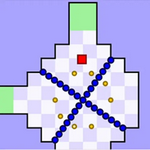
dodge Unblocked
## The Enduring Appeal of Dodge Games: More Than Just Avoiding Obstacles
Dodge games, seemingly simple in their premise, hold a surprising amount of depth and enduring appeal. From the classic arcade experience of dodging falling objects to the intricate, reflex-testing challenges of modern mobile titles, the core gameplay loop remains surprisingly captivating across genres and generations. This inherent simplicity, however, masks a sophisticated blend of skill, strategy, and pure adrenaline.
At their heart, dodge games are about precision and reaction time. Success hinges on anticipating movement, predicting patterns, and reacting swiftly. This makes them inherently satisfying to master; the feeling of flawlessly navigating a seemingly impossible barrage of obstacles is incredibly rewarding. The progression curve, often steep but achievable, keeps players engaged as they hone their skills and push their limits.
The evolution of the dodge game genre is fascinating. Early examples like *Frogger* and *Space Invaders* established the foundational principles: simple controls, escalating difficulty, and a clear objective. These games thrived on their addictive nature, demanding quick reflexes and strategic maneuvering within confined spaces.
Modern dodge games have expanded on this foundation considerably. Titles like *Geometry Dash* introduce intricate level design, demanding precise timing and memorization. Others, like *Temple Run* and *Subway Surfers*, incorporate running mechanics and power-ups, adding layers of strategy and resource management to the core dodge gameplay. Even seemingly disparate genres like rhythm games often incorporate dodge mechanics, demanding synchronization of movements with the music.
But what is it about these games that continues to captivate? The answer lies in their accessibility and addictive nature. The rules are easy to grasp, but mastering them requires dedication and practice. This creates a satisfying loop of learning, improvement, and the pursuit of higher scores. The immediate feedback – success or failure – provides constant reinforcement, driving players to push for better performance.
Furthermore, the visual and auditory stimulation in many dodge games enhances the experience. Bright colors, dynamic sound effects, and intense music create an immersive atmosphere that heightens the sense of urgency and accomplishment. The thrill of narrowly avoiding disaster is a powerful motivator, fueling the desire to play "just one more time."
In conclusion, dodge games are more than just a simple test of reflexes. They are a testament to the power of elegant game design, showcasing how a seemingly straightforward concept can evolve into a diverse and engaging genre. From classic arcade titles to sophisticated mobile experiences, the enduring appeal of dodge games lies in their accessibility, challenging gameplay, and the undeniable satisfaction of mastering the art of avoidance.









































